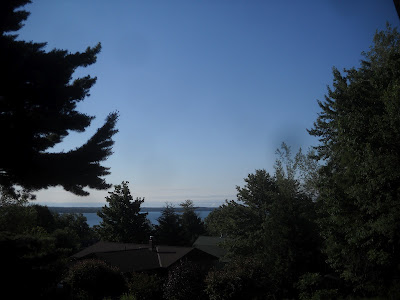 |
| RED ELDERBERRY |
 |
| 'BLACK LACE' ELDERBERRY... |
 |
| ...FLOWER HEAD |
 |
| CAUTION! BEARS AT WORK |
 |
| BEAUTIFUL MORNING |
Sunday, 64 degrees F, wind NW, light. The sky is virtually clear except for some clouds and haze on the eastern horizon. The humidity is 80% and the barometer is high. It is a beautiful morning, except that Buddy took off on me for about ten minutes while we were on our walk. He is so quick he can disappear in an instant and then feels free to run, shock collar or not. I scolded him, but one can’t punish the dog for coming back, or the next time he might not. Buddy is not an easy training subject but we are making progress.
The neighborhood bear is still around as evidenced by the overturned dumpster in the next block.
The common elderberry, Sambucus canadensis, is a large native shrub, quite noticeable in flower and fruit but seldom used in landscaping except for perhaps naturalizing large borders. Its berries are often used to make jelly and wine but it is reported to be toxic to some individuals. We used to make lacy pancakes of the flowers by dipping them in batter and frying them. It is common throughout the US east of the Rocky Mountains. I forgot to take a photo of it wile we sere traveling and it is not much seen this far north.
Pictured is a horticultural selection of the common elderberry named ‘Black Lace,’ which is very showy and unusual. This one is on Mannypenny Ave. and about Fourth Street, but there are others around town.
Although such horticultural oddities are often very beautiful they can be hard to use in landscape design, being too bold, or even unnatural, in appearance. “Black Lace” is best used at the back of a showy perennial border or as an unusual accent plant. I have also mentioned the northern red elderberry, S. pubens, which is now bearing fruit. The two species and the horticultural variety provide an interesting view of how the species of a genus can vary, and how horticultural selections can vary even more.
Political commentary: never on Sunday











No comments:
Post a Comment